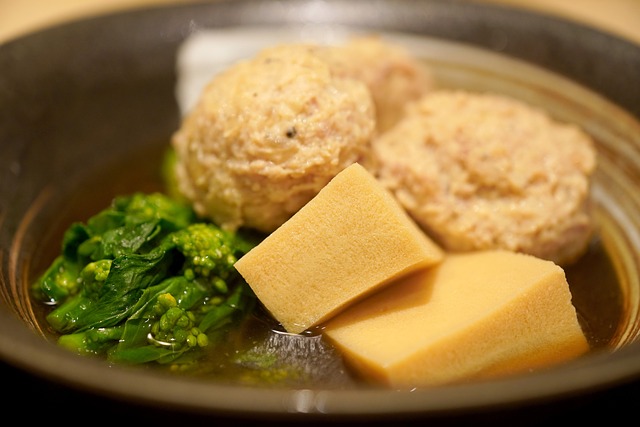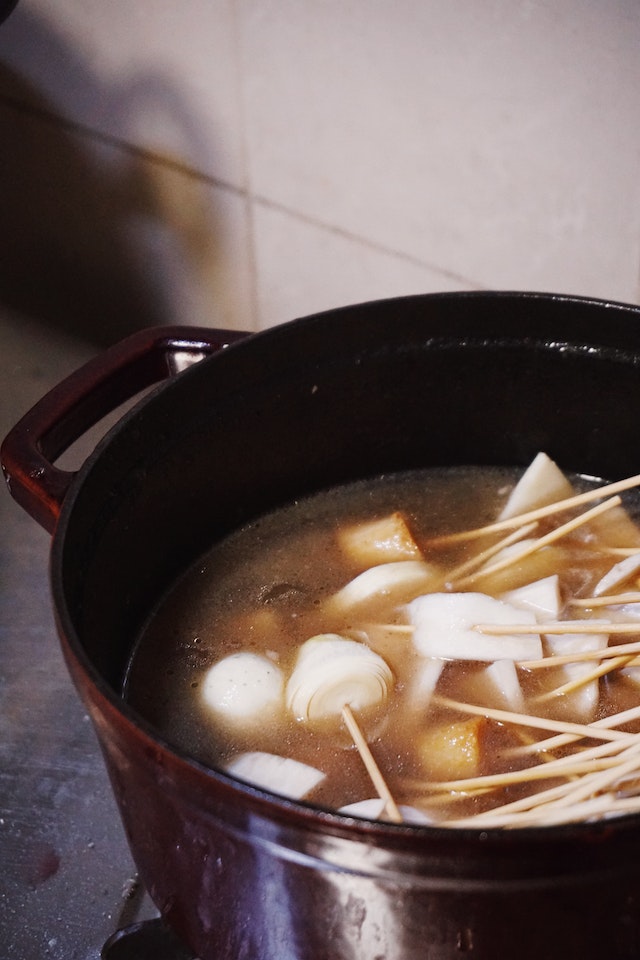
Nimono is a traditional Japanese dish that has been enjoyed for centuries. Like many Japanese dishes, it is made with fresh and seasonal ingredients, highlighting the importance of sustainability and the connection between nature and food.
At its core, Nimono is a one-pot dish that is simmered over a low heat until the flavors of the ingredients meld together in a delicious broth. The broth can be made with a variety of ingredients, such as dashi (a Japanese stock made from fish and kelp), soy sauce, mirin (a sweet cooking sake), and sake, giving it a deep and savory flavor that is unique to Japanese cuisine.
Cultural Significance of Nimono
Nimono, with its careful preparation and emphasis on fresh ingredients, is a dish that encapsulates the essence of Japanese culinary philosophy. In Japanese cuisine, the focus is not just on the taste of the food but also on its aesthetic presentation. Nimono exemplifies this approach, with its beautifully arranged ingredients and delicate broth.
The art of preparing Nimono has been passed down through generations, preserving traditional cooking methods and techniques. This dish showcases the importance of preserving culinary heritage and valuing the wisdom of ancestors. By preparing Nimono, individuals connect with their cultural roots and demonstrate respect for the past.
Seasonality and Sustainability in Nimono
Japanese culture places great importance on seasonality and sustainability in food. Nimono utilizes fresh and seasonal ingredients, harnessing the flavors and nutrients that nature offers at different times of the year. By using what is readily available, Nimono encourages a closer connection to the environment and an appreciation for the natural world.
At the heart of Nimono is the art of simmering. This slow and steady cooking method allows flavors to meld together, creating a harmonious broth. The gentle heat used in simmering draws out the essence of each ingredient, resulting in a dish that is deeply satisfying and layered with complex flavors.
Nimono as a Symbol of Hospitality
In Japanese culture, preparing and serving food is a way of expressing hospitality and care for others. Nimono exemplifies this concept, as it is often prepared with love and presented beautifully to guests. Sharing a warm, comforting dish of Nimono is a gesture of goodwill and a chance to connect with loved ones.
Essential Ingredients and Equipment
Preparing Nimono requires a few key ingredients and equipment to ensure the authentic flavors and the perfect simmering process. Here is a comprehensive guide to the essential components:
Fresh and Seasonal Ingredients:
- Daikon: This crisp and slightly sweet Japanese radish is a staple in Nimono. Choose firm daikon with smooth skin for the best taste.
- Carrots: Add a touch of vibrant color and sweetness to the dish with tender carrots. Opt for organic carrots whenever possible.

- Shiitake Mushrooms: These meaty mushrooms lend a rich umami flavor to the broth. Select mushrooms with firm caps and closed gills.
- Lotus Roots: Known for their crunchy texture and mild flavor, lotus roots provide an intriguing element to Nimono.
- Protein (optional): Chicken, fish, or tofu can be added to make Nimono a complete meal. Ensure your choice is fresh and of high quality.
Flavorful Broth Components:
- Dashi Stock: A vital ingredient in Japanese cuisine, dashi is made from fish flakes (like bonito) and kelp. It forms the base of the flavorful broth.
- Soy Sauce: Choose a good quality soy sauce that adds depth and savoriness to the dish.
- Mirin: This sweet cooking sake adds a subtle sweetness and balances the flavors. Look for mirin without additives or preservatives.
- Sake: A traditional Japanese rice wine, sake helps enhance the aroma and complexity of Nimono’s broth.
Cooking Equipment:
A Sturdy Pot: Select a pot that is large enough to hold all the ingredients and has a tight-fitting lid to ensure even heat distribution and prevent evaporation.
A Simmer Plate: This handy equipment helps regulate the heat and maintain a gentle simmer throughout the cooking process.
Sharp Knives: Nimono requires precise knife work, so ensure you have sharp knives for efficiently slicing and preparing the ingredients.
Remember, the key to remarkable Nimono lies not only in the ingredients and equipment but also in the love and mindfulness you bring to your cooking. Take your time, embrace the artistry, and savor the beautiful flavors that Nimono has to offer.
Understanding the Nimono Process
Preparing a traditional Nimono requires a delicate balance of flavors and a patient approach. Each step contributes to the layers of taste and the harmonious melding of ingredients. Here is a step-by-step guide to help you master the art of Nimono:
Preparing the Ingredients
- Wash and peel the daikon radish, carrots, and lotus roots. Slice them into bite-sized pieces.
- If using shiitake mushrooms, gently wipe them with a damp cloth to remove any dirt. Remove the stems and slice the caps.
- If adding protein, ensure it is properly cleaned and cut into appropriate portions.
Creating the Broth
- In a sturdy pot, add the dashi stock and bring it to a gentle simmer over medium heat.
- Gradually add soy sauce, mirin, and sake, tasting as you go to achieve the desired balance of flavors.
- Allow the broth to infuse with the seasonings for a few minutes, enhancing its depth and complexity.

Simmering the Ingredients
- Add the daikon, carrots, lotus roots, and shiitake mushrooms to the pot, ensuring they are submerged in the broth.
- If using protein, carefully arrange the pieces on top of the vegetables.
- Reduce the heat to low and cover the pot with a tight-fitting lid.
- Simmer the Nimono slowly, allowing the ingredients to absorb the flavors of the broth. This gentle cooking method ensures tender, infused ingredients.
- Keep an eye on the pot, occasionally checking the liquid level. If necessary, add more broth or water to prevent it from drying out.
Adjusting the Seasonings
- Once the ingredients are tender, taste the broth and make any necessary adjustments to the seasonings. Adding a touch more soy sauce, mirin, or sake can enhance the dish’s overall balance.
- Remember, the flavors should be well-rounded, with hints of sweetness, saltiness, and umami.
Final Touches
- Carefully transfer the Nimono to a serving dish, ensuring to arrange the ingredients in an aesthetically pleasing manner.
- Garnish with some chopped green onions or a sprinkle of toasted sesame seeds for an added hint of freshness or nuttiness.
- Serve the Nimono hot with steamed rice or noodles, allowing the flavors to come together in a comforting and satisfying meal.
As you become more familiar with the dish, feel free to experiment with different ingredients, adjusting the flavors to suit your preferences. With time and practice, you will master the art of Nimono, impressing your loved ones with an exquisite symphony of tastes and textures.
Popular Nimono Dishes

Oden: Oden is a classic Japanese winter comfort food that features an assortment of ingredients, such as boiled eggs, fish cakes, daikon, konnyaku (a type of yam cake), and tofu, simmered in a soy-based broth. It is often enjoyed with karashi (Japanese mustard) for a spicy kick.
Nikujaga: Nikujaga literally translates to “meat and potatoes” and is a beloved Japanese homestyle dish. It consists of thinly sliced beef, potatoes, carrots, onions, and konnyaku, simmered in a flavorful soy sauce and sake broth. This hearty stew is enjoyed alongside a steaming bowl of rice.
Takenoko Nimono: Takenoko refers to bamboo shoots, and this Nimono dish showcases their delicate flavor and texture. The bamboo shoots are first boiled to remove their bitterness and then simmered in a savory broth with other seasonal vegetables like carrots, shiitake mushrooms, and peas. It is a refreshing and earthy dish that celebrates the arrival of spring.
Kabocha Nimono: Kabocha, a Japanese pumpkin, is the star ingredient in this Nimono dish. The kabocha is cut into slices or chunks and simmered in a savory broth until tender. The natural sweetness of the pumpkin is enhanced by the umami flavors of the broth, creating a delightful combination of tastes.
Tori dango Nimono: Tori dango, or chicken meatballs, are a popular addition to Nimono dishes. Made from ground chicken mixed with seasonings and shaped into bite-sized balls, tori dango add a protein-rich element to the simmering pot. They absorb the flavors of the broth while retaining their moist and tender texture.
Gobo Nimono: Gobo, also known as burdock root, is a long and slender root vegetable with a mild and slightly sweet flavor. When cooked in Nimono, gobo becomes tender and takes on the savory notes of the broth. It is often paired with carrots and other vegetables, creating a colorful and nutritious dish.
Tofu Nimono: Tofu, a staple in Japanese cuisine, is a versatile ingredient that can be simmered in Nimono for a soft and tender texture. It soaks up the flavors of the broth and pairs well with various vegetables and proteins. Tofu Nimono is a popular choice for those seeking a vegetarian or vegan option.
Anko Nimono: Anko, or sweet red bean paste, may seem like an unusual choice for Nimono, but it is a delightful treat for those with a sweet tooth. Anko is simmered gently in a light syrup broth until it becomes soft and velvety. It can be enjoyed as a dessert or a sweet accompaniment to other savory dishes.
These popular Nimono dishes showcase the versatility and creativity of Japanese cuisine. Whether you prefer a hearty stew, a light and refreshing dish, or a touch of sweetness, there is a Nimono variation to satisfy your cravings.
Nimono is more than just a dish; it is a reflection of Japanese culture and culinary traditions. From its careful preparation to its emphasis on seasonality and sustainability, Nimono embodies the essence of Japanese culinary philosophy. By preparing and sharing this dish, individuals connect with their cultural heritage, preserve traditional cooking methods, and express hospitality to others. So, next time you simmer a pot of Nimono, you are not just creating a delicious meal, but also participating in a centuries-old tradition that celebrates the harmony of food, nature, and community.

